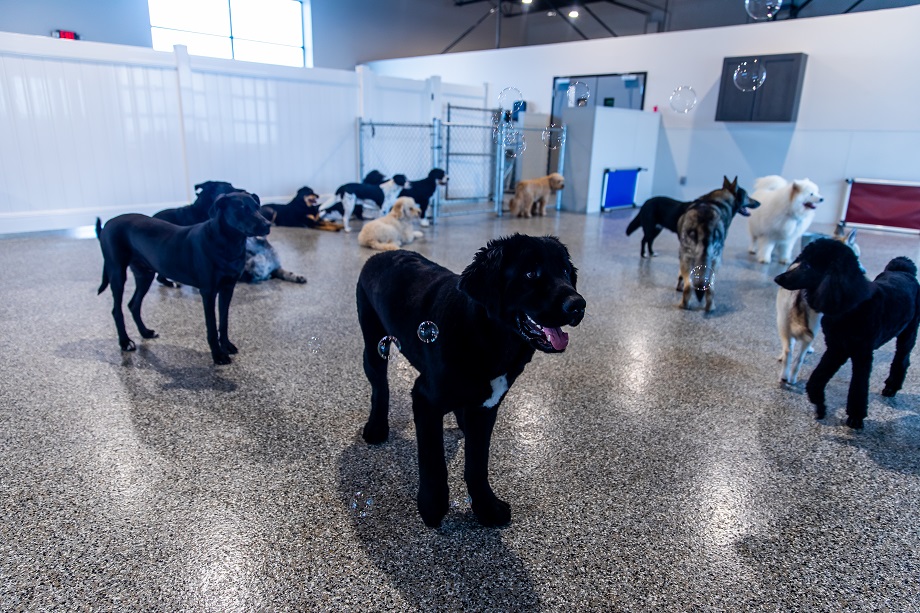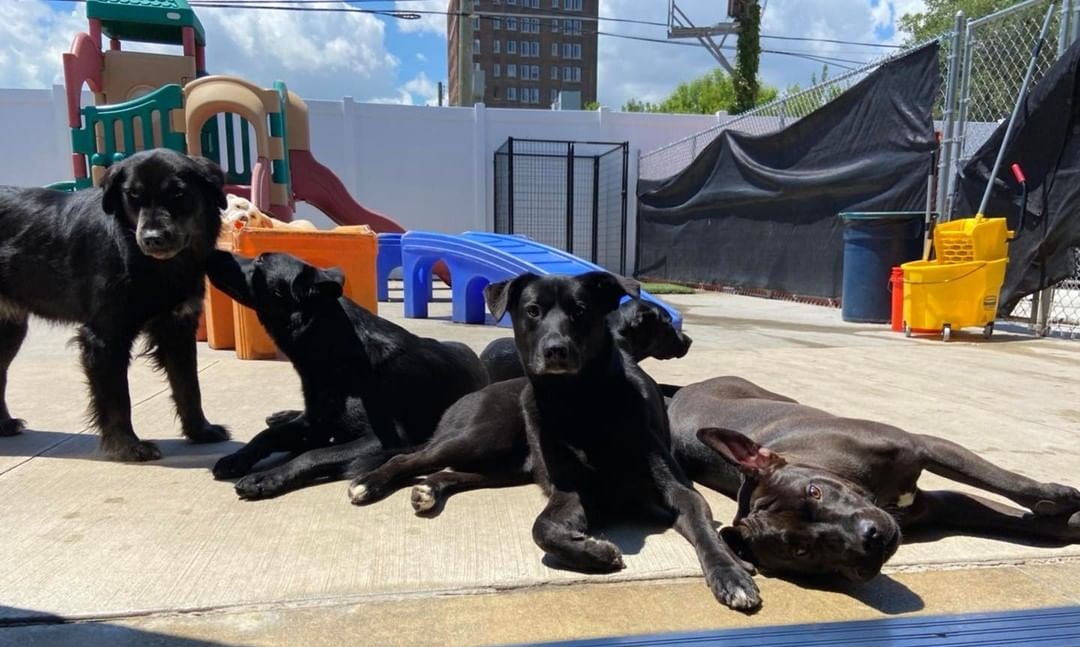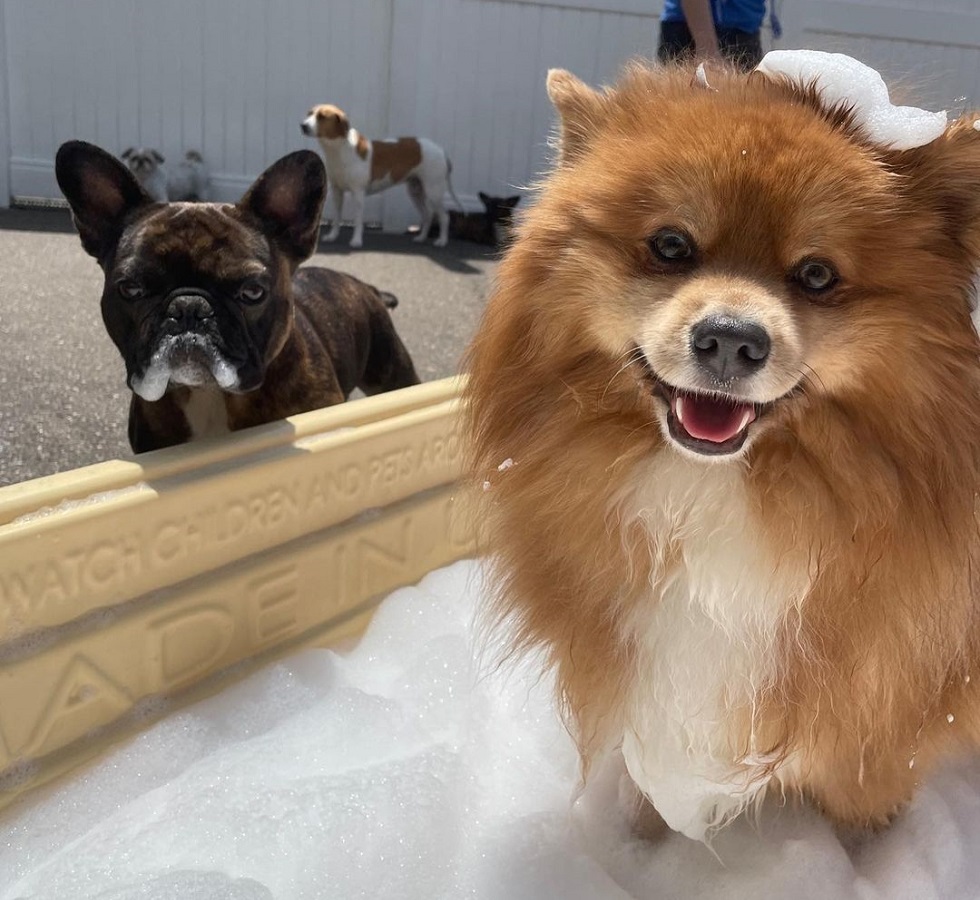Are all dog daycares just over exciting free for alls?

Canine to Five recently received the above question from a potential new customer, and we thought it gave us a great opportunity to share a bit of our inner workings, so to speak. If you’ve ever wondered what goes on once your dog gets led into daycare by one of our handlers, read on for some insight into how we work!
What a great question! The short answer is that Canine to Five is a facility that watches dogs for signs of stress and keeps them in smaller groups. But don’t just take my word for it; please read on for the long answer, which details how daycare truly “works” for each and every dog that we care for.
Over the years, I have grown to think of a dog daycare as a school that serves four-legged students from Pre-K all the way through high school.
For some kids, going to school for the first time is no big thing. There’s no backwards glance at mom and dad on the first day, no tears. This kid is stoked to be there to learn and play and meet other kids and, without even being aware that it’s happening, develop social skills as well.
For others, that first day can be a big scary thing. This kid needs a little bit more support and frequent breaks to get them through any period of adjustment. But most kids will adjust after a few weeks, and begin to thrive. It helps immensely that they are being closely watched by people that are trained to see the signs and can offer guidance when they’re feeling overwhelmed or worried.
Ultimately, they will start to feel comfortable with the daily routine and their classmates. They start to trust their teacher and feel like s/he is looking out for them and has their back. They get used to going outside for recess in a controlled manner; they learn when play time, learning time, and nap time are.
There are times on the playground where there is a rise in anxiety for someone, a little disagreement, or energy gets a little too high. And some “kids” are drawn to that…
In this analogy, our job, as pet care professionals, is to help mitigate this exact situation. We are constantly considering the following things to see what and where things can go wrong:
- The class size and the number of teachers on the playground. Are there enough teachers, and are they paying attention?
- Has the kid been successfully been taught how to play with friends without supervision, how to handle conflict, and to leave and ask for help when something is going wrong?
- Do the kids have the skills necessary to handle conflict or a rise in arousal?
- Is the kid super-hyper or super-chill? The hyper ones will run around like maniacs in an uncontrolled playground, and the chill ones will just enjoy the swings and monkey bar.
We aim to staff 1 “teacher” per 16-18 kids, er, dogs. Our handlers know when it’s time for a dog to take a rest, or when they are participating in healthy play, and not off practicing behaviors that might not be healthy play, or life behaviors to rehearse either at daycare or at home. We always work to make sure that we are there to help so there is never the need for a dog to respond aggressively out of fear.
One example is our Serenity Lounge. Think of this as the option to stay inside when other kids go crazy at recess. Some kids just want to color on their own, or read. Some want to play one on one with a friend. Some want to rest or maybe hang out by the teacher a bit. This is what the Canine To Five Serenity Group is – a place for dogs to enjoy a social setting but not be overwhelmed by the dodgeball game on the playground.
But there’s more than just the Serenity Lounge as an alternative to active group play. We have split our playroom into multiple spaces for dogs with different needs:
- Puppy Preschool – Ages 12 weeks to 8 months. They are grouped by play style, age, and somewhat by size. Puppies have small groups, frequent breaks, reinforcement available for behaviors we like, and a ratio of one staff person to every 5 dogs so that we can make sure we are there to help them through each and every situation they encounter.
- Tiny Town – For dogs of all ages that weigh in under 35 lbs. Often, this group will be split into different spaces to keep dogs of the same play style together.
- Social Setting – This is for dogs who enjoy play, lots of socialization, and being in a big group of dogs. Going back to the school analogy, these social butterflies like football games and dances and parties.
- Serenity Lounge – Our low arousal group. This is for the adult dog (or sometimes even teenage dog) who does not want to stay home alone, but does not want to join the student council. They are fine playing with one other dog maybe, or just chilling next to another dog. Maybe they want to lie down all day – that’s fine. Serenity is the place for this. There is just nice, calm play, with teachers who are always looking out to make sure all the dogs are feeling very safe and comfortable. Ideal for dogs that are stressed by rough play, running, or having dogs bump into them, jump on them, etc.
If it were a school, Canine To Five would be on the larger side as a facility, but it would boast medium class sizes. We intentionally broke up our school into smaller classes so that we could create private, small group experiences while enjoying the luxuries and amenities of a larger facility. So, at first glance, we have a lot of room and take in a lot of dogs, but the dogs are never just in one big room and our ratios are very, very low so that we can make sure all dogs have great play, and not just dogs that like roughhousing and intense play.
We put a lot of time into our programs and pay a force-free, certified behavior consultant to come in every single month to help our staff learn more about dogs and get as much continuing education as possible. We are hyper trained to read body language and make sure all dogs are feeling comfortable and happy in group while they are with us. If there is anything to change, adjust, or modify to stay up-to-date, science-based, and the best possible place for your pet while you’re away, we’re on it! And, as always, I am always, always happy to answer any questions or discuss further.
Sincerely, Liz Blondy
Owner
Want to become a member of our pack? Here’s what you’ll need to start at Canine to Five:
- Your pup must be at least 12 weeks old
- They must have their DHPP, Lepto, Bordetella, and Rabies vaccines (Rabies by 18 weeks old for puppies)
- Puppies over 9 months old must be spayed/neutered to participate in our pack-style environment; Unaltered dogs may continue to join us for Private Play
If your dog is eligible to start, click here to fill out our new client inquiry form and our Canine Concierge will get in touch with you to go over next steps!




